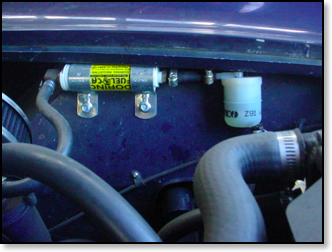No Leaded Fuel?
Here is a summary of the situation, as it applies to most BMC engines (Sprite, Mini, MG). The information has been obtained from various publications, brochures, and from discussions with the “fuel engineers” from BP, Shell, Caltex and Mobil.
This is intended as a guide only, and no independent proof has been sought for any information contained herein.
Our problem comes in three parts.
Firstly, when our cars were designed, the engine’s compression ratio required a relatively high octane fuel to eliminate pre-ignition (or “pinging”). “Super” fuel was ideal, at 98 octane, compared with “standard” fuel at 90 to 92 octane. Over the last few years, the octane rating of Super has gradually reduced – and yes, that’s one of the reasons you car has started pinging and isn’t performing as well as it used to, even though you have still used Super fuel.Secondly, our engines have cast iron cylinder heads, and the iron on the exhaust valve seat needs protection from the extreme heat of the burnt gases passing across it. This protection has been provided in the past by the minute quantities of lead in the fuel. Without such protection, microscopic particles of cast iron melt and deposit themselves on the (harder) exhaust valve face. Over a period of time, the valve seat erodes (termed “valve seat recession”) and the head is progressively damaged with subsequent loss in power.
And if that isn’t enough, the gradual elimination of Sulphur from fuel (not well publicised) has resulted in a lower shelf life for unleaded fuel. Oil companies surveyed estimated that a half full tank of unleaded could be unusable in as little as 2 months! Sulphur used to be added as a preservative to slow down algae growth in the fuel. Without it, the algae grow and the fuel quality deteriorates. How old is the fuel in your tank now?
So what are the options?
Have your engine converted to hardened valve seats.Might be an option, but not a cheap one.
Unfortunately, in many BMC engines, there is very little room between the inlet and exhaust valves. With some cylinder heads, a hardened exhaust valve insert will actually overlap into the inlet seat! For this reason, there is a possibility of the valve seat insert dropping out, with disastrous overall consequences to your engine.
Just use high octane unleaded, such as Shell Optimax or BP Ultimate.
Don’t! This will stop the pinging, and you may think your problem has been solved, but without valve seat protection you could (depending on your driving style) destroy your engine in a few thousand miles.
Use Lead Replacement Petrol (LRP).
Could be an option.
Many different substances have been tried for valve seat protection. Overseas tests have shown that petrol engines with standard valve seats, using Sodium based LRP, experienced serious valve wear at only 1,000 kms. When using Potassium based additive at four times the recommended level, valve adjustments were required at only 2,000 kms and cylinder heads were worn out at 10,000 kms. When Phosphorous is used, corrosion problems are occurring at the levels required to prevent valve seat recession. Manganese has also been tried – resulting in fouled spark plugs in less than 1,000 kms. Mobil and Caltex use Manganese, Shell use Phosphorous, and BP use Potassium.
So I guess it’s fair to say that know-one is certain which additive is the best. Isn’t it comforting then to know they are experimenting with so many additives, on our cars!!!!!!!! In any case, LRP isn’t enough for our engines. One oil company spokesman has openly stated that LRP is not suitable for highway use, and over the counter they sell syringes of additive to put in your tank of LRP!
Use a fuel additive, available from Repco, AutoPro, Auto One etc.
An easy solution, and cheap in the short term. However, which additive will you chose – one with Sodium, Potassium, Phosphorous, or Manganese?
See above.
Fit an in-line tin-alloy fuel catalyst, then use unleaded fuel.
A good option, not cheap in the short term, but a "fit and forget" solution.
In-line tin-alloy catalysts have been used for over 50 years, and there are at least twenty different types on the world market. Their main claim is the catalytic action in breaking up the long-chain hydrocarbon molecules into short chain lengths. This apparently greatly increases the cetane (burning rate) of fuels, which results in more efficient combustion and an improvement in fuel economy. There is also less carbon deposited on cylinder heads and you engine oil stays cleaner. In addition, a minute quantity of tin is added to the fuel, which is deposited on the valve seat extending cylinder head and valve life.

The fuel catalyst as fitted to my Austin
Sprite
At the end of the
day, we are all in the same situation.
"You pays your money and you takes
your chances."
Colin Dodds
B Sc, AMIAME
